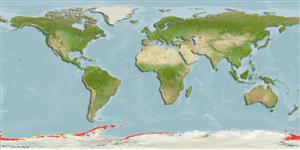Common names from other countries
Environment: milieu / climate zone / depth range / distribution range
Ecologia
marino benthopelagico; distribuzione batimetrica 20 - 900 m. Polar; 60°S - 78°S
Southern Ocean: Circum-Antarctic on the continental shelf and slope.
Size / Peso / Age
Maturity: Lm ? range ? - ? cm
Max length : 56.0 cm TL maschio/sesso non determinato; (Ref. ); peso massimo pubblicato: 1.1 kg (Ref. 124149)
Adults feed mainly on fishes and krill (Ref. 5200).
Iwami, T. and K.-H. Kock, 1990. Channichthyidae. p. 381-389. In O. Gon and P.C. Heemstra (eds.) Fishes of the Southern Ocean. J.L.B. Smith Institute of Ichthyology, Grahamstown, South Africa. 462 p. (Ref. 5200)
IUCN Red List Status (Ref. 130435)
CITES (Ref. 128078)
Not Evaluated
Threat to humans
Harmless
Human uses
Pesca: di nessun interesse
Strumenti
Special reports
Download XML
Fonti Internet
Estimates based on models
Preferred temperature (Ref.
115969): -1.8 - 1.1, mean -1 (based on 533 cells).
Phylogenetic diversity index (Ref.
82804): PD
50 = 1.0000 [Uniqueness, from 0.5 = low to 2.0 = high].
Bayesian length-weight: a=0.00155 (0.00083 - 0.00287), b=3.39 (3.23 - 3.55), in cm Total Length, based on LWR estimates for this species & (Sub)family-body (Ref.
93245).
Trophic level (Ref.
69278): 3.4 ±0.48 se; based on food items.
Resilienza (Ref.
120179): Medio, tempo minimo di raddoppiamento della popolazione 1.4 - 4.4 anni (Assuming Fec < 10,000).
Fishing Vulnerability (Ref.
59153): Moderate vulnerability (42 of 100).
Climate Vulnerability (Ref.
125649): High to very high vulnerability (73 of 100).
